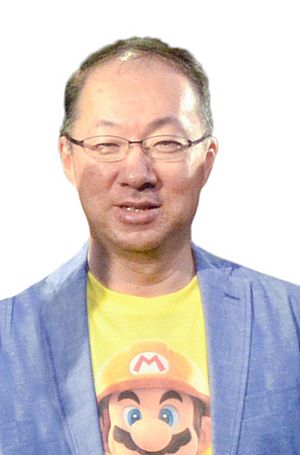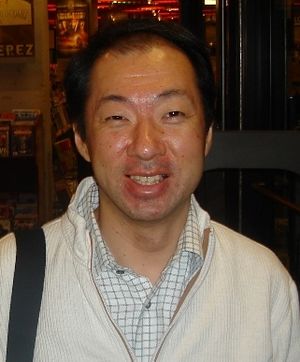Koji Kondo facts for kids
Quick facts for kids
Koji Kondo
|
|
|---|---|
| 近藤 浩治 | |

Kondo in 2015
|
|
| Born | August 13, 1961 |
| Alma mater | Osaka University of Arts |
| Occupation |
|
| Years active | (1984–present) |
| Employer | Nintendo |
| Musical career | |
| Genres |
|
| Instruments | Piano |
Koji Kondo (Japanese: 近藤 浩治, Hepburn: Kondō Kōji, born August 13, 1961) is a Japanese composer. He works as a senior leader at Nintendo, a famous video game company. He is famous for creating music for the Super Mario and The Legend of Zelda games. His Super Mario Bros. theme song was the first video game music to be added to the American National Recording Registry. This means it is considered very important music! Nintendo hired Kondo in 1984. He was their very first composer who focused only on music. Today, he is a Senior Officer in Nintendo's Entertainment Planning & Development division.
Contents
Koji Kondo's Early Life
Koji Kondo was born in Nagoya, Japan, on August 13, 1961. He started music classes at a young age. From age five, he learned to play the electronic organ at Yamaha Music classes. Kondo also played the marimbas in his elementary school band. Later, he played the electronic organ in a band that performed jazz and rock music. Kondo studied at the Art Planning Department of Osaka University of Arts. He did not have formal classical music training.
Kondo loved arcade video games like Space Invaders and the early Donkey Kong series. He felt that video games were the best place for the kind of sound creation he wanted to do. He gained experience by composing and arranging music. He also learned computer programming. He used a piano and a computer to program music for the Famicom using Famicom BASIC.
Koji Kondo's Career at Nintendo
In 1984, Koji Kondo applied for a job at Nintendo. He wanted to compose music and program sounds. He found the job listing on his school's job board. Kondo loved making synthesizers and playing games. He thought Nintendo was the perfect place for him. He only interviewed with Nintendo and has worked there ever since. Kondo was the third person Nintendo hired to create game music and sound effects. However, he was the first person at Nintendo to specialize only in music composition.
First Projects and Punch-Out!!
Kondo's first project at Nintendo was the sound design for the 1984 arcade game Punch-Out!!. The Famicom console was very popular in Japan at that time. So, Kondo was asked to compose music for games on this console. These games were made at Nintendo's new development group, Nintendo Entertainment Analysis and Development (EAD). His second project was writing an instruction manual. This manual taught people how to program Japanese popular music into the Famicom using a device called Family BASIC. By the end of his first year, he helped create some music for Devil World with Akito Nakatsuka.
Success with Super Mario Bros.
In 1985, Nintendo started selling the Famicom outside Japan. It was called the Nintendo Entertainment System (NES). This helped Nintendo after the 1983 video game crash that hurt other companies. Super Mario Bros. was Kondo's first big music project. He created the game's melodies so that short parts of the music could repeat without players getting bored. The main theme is very famous in popular culture. It has been played in over 50 concerts. It was also a best-selling ringtone and has been used by many musicians.
Music for The Legend of Zelda
Kondo's music for The Legend of Zelda games is also very well-known. He made four main background music pieces for the first game in the series. The overworld theme is almost as popular as the Super Mario Bros. main theme. After The Legend of Zelda was a hit, he made music for two games released only in Japan. These were The Mysterious Murasame Castle (1986) and Shin Onigashima (1987). He also created the music for Yume Kōjō: Doki Doki Panic (1987). This game was later released outside Japan as Super Mario Bros. 2 in 1988.
Later Super Mario and Zelda Games
Kondo returned to the Super Mario series. He created the music for Super Mario Bros. 3 (1988) and Super Mario World (1990). Super Mario World was a launch title for the SNES. Koichi Sugiyama led a jazz music album for Super Mario World. He also oversaw its performance at the first Orchestral Game Musical Concert in 1991. After Super Mario World, Kondo worked on sound programming for Pilotwings (1990). He also composed its "Helicopter Theme." He created sound effects for Star Fox (1993). In 1995, he composed music for Yoshi's Island, a sequel to Super Mario World.
Until the early 2000s, Kondo usually wrote all the music for a project by himself. The Legend of Zelda: Ocarina of Time was the last game he worked on alone. Since then, he has worked with other Nintendo staff. He advises and supervises music made by others. He also adds his own compositions to games. These include Super Mario Galaxy, The Legend of Zelda: Spirit Tracks, The Legend of Zelda: Skyward Sword, and Super Mario 3D World. Kondo was also the main composer for Super Mario Maker and Super Mario Maker 2. He was a consultant for the music in The Super Mario Bros. Movie (2023).
Concerts and Performances
Kondo attended the first performance of Play! A Video Game Symphony in Chicago in May 2006. A full orchestra played his music from the Super Mario Bros. and The Legend of Zelda series. Kondo also attended and performed in three concerts in late 2011. These concerts celebrated the 25th anniversary of The Legend of Zelda series. He played piano with the American rock band Imagine Dragons at The Game Awards 2014 in December 2014.
Koji Kondo's Musical Style
Kondo designed his music for Super Mario Bros. to feel like motion. This matched the player's physical experience in the game. The game's creator, Shigeru Miyamoto, wanted the audio to have "substance." He also wanted it to be in sync with game elements. Because of this, Kondo based most of the music on dance genres. These included Latin music and the waltz.
In the first The Legend of Zelda game, Kondo used different themes for the overworld and dungeons. Kondo said it was important for music to show distinct characters. This way, players would know where they were in the game right away. Kondo used this idea of contrast in other games, like Super Mario Bros. Kondo has said that Deep Purple, Yes, Emerson, Lake & Palmer, Herbie Hancock, Chick Corea, and Casiopea have influenced his music.
Koji Kondo's Works
| Year | Title | Role(s) |
|---|---|---|
| 1984 | Punch-Out!! | Music, sound effects |
| Golf | Sound effects | |
| Devil World | Music with Akito Nakatsuka | |
| 1985 | Soccer | Music, sound effects |
| Arm Wrestling | Music, sound effects | |
| Kung Fu | Sound effects | |
| Super Mario Bros. | Music, sound effects | |
| 1986 | The Legend of Zelda | Music, sound effects |
| The Mysterious Murasame Castle | Music, sound effects | |
| Super Mario Bros.: The Lost Levels | Music, sound effects | |
| Volleyball | Music, sound effects | |
| 1987 | Yume Kōjō: Doki Doki Panic | Music, sound effects |
| Shin Onigashima | Music, sound effects | |
| 1988 | Super Mario Bros. 2 | Music, sound effects |
| Super Mario Bros. 3 | Music, sound effects | |
| 1990 | Super Mario World | Music, sound effects |
| Pilotwings | Sound programmer; composed "Helicopter Theme" | |
| 1991 | The Legend of Zelda: A Link to the Past | Music, sound effects |
| 1993 | Star Fox | Sound effects |
| 1995 | Yoshi's Island | Music, sound effects |
| 1996 | Super Mario 64 | Music |
| 1997 | Star Fox 64 | Music with Hajime Wakai |
| 1998 | The Legend of Zelda: Ocarina of Time | Music |
| 2000 | The Legend of Zelda: Majora's Mask | Music with Toru Minegishi |
| 2002 | Super Mario Sunshine | Music with Shinobu Tanaka |
| The Legend of Zelda: The Wind Waker | Music with Kenta Nagata, Hajime Wakai, and Toru Minegishi | |
| 2004 | The Legend of Zelda: Four Swords Adventures | Music with Asuka Hayazaki |
| 2006 | New Super Mario Bros. | Sound director; composed "Overworld Theme" |
| The Legend of Zelda: Twilight Princess | Music with Toru Minegishi and Asuka Hayazaki | |
| 2007 | Super Mario Galaxy | Music with Mahito Yokota |
| 2008 | Super Smash Bros. Brawl | "Ground Theme (Super Mario Bros.)" |
| 2009 | The Legend of Zelda: Spirit Tracks | "Ending Theme" |
| 2010 | Super Mario Galaxy 2 | Music with Mahito Yokota and Ryo Nagamatsu |
| 2011 | The Legend of Zelda: Skyward Sword | "An Ages-Old Tale" |
| 2013 | Super Mario 3D World | Music with Mahito Yokota, Toru Minegishi, and Yasuaki Iwata |
| 2014 | Super Smash Bros. for Wii U | "Super Mario Bros. Medley" |
| 2015 | Super Mario Maker | Music with Naoto Kubo and Asuka Hayazaki |
| 2017 | Super Mario Odyssey | Music with Shiho Fujii and Naoto Kubo |
| 2018 | Super Smash Bros. Ultimate | "King Bowser (Super Mario Bros. 3)" |
| 2019 | Super Mario Maker 2 | Music with Atsuko Asahi, Toru Minegishi, and Sayako Doi |
| 2023 | Super Mario Bros. Wonder | Music with Shiho Fujii, Sayako Doi, and Chisaki Shimazu |
Awards and Legacy
| Year | Nominee / work | Award | Result |
|---|---|---|---|
| 2011 | Super Mario Galaxy 2 | British Academy Games Awards (Best Original Music) | Nominated |
| 2014 | Super Mario 3D World | British Academy Games Awards (Best Original Music) | Nominated |
| Video Game Music Online (Best Soundtrack – Retro / Remixed) | Nominated |
Kondo's work helped game music change. It went from simple tunes to more complex and orchestral pieces. In 2024, he was added to the Academy of Interactive Arts & Sciences' Hall of Fame. This is a very special honor for people who have made a big impact on video games.
See also
 In Spanish: Koji Kondo para niños
In Spanish: Koji Kondo para niños


